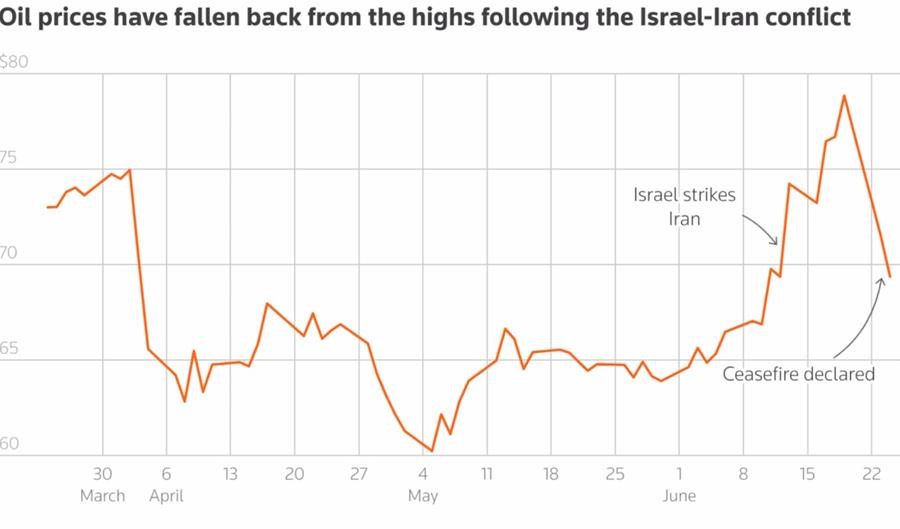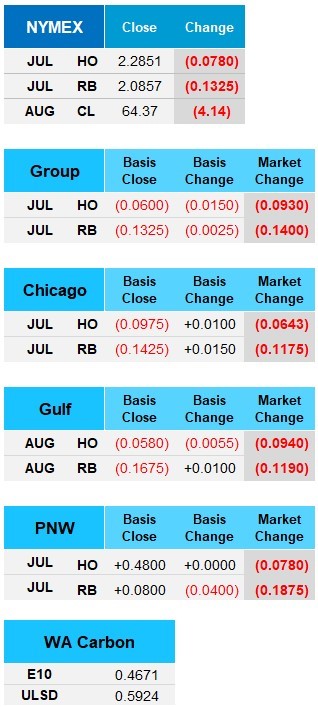Ceasefire: A ceasefire between Iran and Israel was announced by U.S. President Donald Trump after a 12 day conflict marked by U.S. airstrikes on Iranian nuclear facilities and Iran’s retaliatory attack on Qatar. Despite the truce, tensions remain, with Israel accusing Iran of firing missiles in violation of the ceasefire, an allegation Iran denies. In response, Israel ordered retaliatory strikes on Tehran, underscoring the fragility of the agreement. The conflict triggered high volatility in oil markets, with crude oil experiencing a $10 swing, its largest since 2022. Oil prices dropped sharply to a two week low after the ceasefire, falling 3.5% as fears of wider supply disruptions eased. The market reacted with relief that the U.S. strikes did not lead to a broader regional war. However, uncertainty around the ceasefire’s durability and the strategic vulnerability of the Strait of Hormuz means geopolitical risks remain elevated.
Rig Count: The number of active oil rigs in the U.S. fell for the eighth consecutive week, dropping by one to 438, which is 47 fewer than the same week in 2024. Despite a recent rise in oil prices, U.S. producers continue to scale back drilling activity. In contrast, Canada's oil rig count rose for the second straight week to 93, although it remains 16 rigs below year ago levels. Rig counts, often seen as a leading indicator of future production, are declining in the U.S. even as geopolitical tensions have driven oil prices higher. Crude oil futures have jumped nearly 11% since Israel began airstrikes on Iran on June 13, with Brent crude seeing even greater gains. However, concerns about oversupply continue as OPEC and its allies plan to increase production by 411,000 barrels per day through the end July.
Crude Oil Prices: Yesterday President Donald Trump called for increased U.S. oil drilling and urged market participants to keep oil prices down following U.S. air strikes on Iran's nuclear facilities. He emphasized the message on Truth Social with "drill, baby, drill" and warned that high prices benefit enemies. Energy Secretary Chris Wright publicly supported the call, though the Department of Energy has limited direct control over private sector drilling. Oil prices surged nearly 6% to a five month high before falling later in the day, as Middle East oil transit remained uninterrupted. Doug Burgum, head of the new National Energy Dominance Council, echoed the push for greater fossil fuel output, framing it as a strategic tool against authoritarian energy regimes like Iran.
Market Overview: Ukrainian forces struck an oil depot in Russia’s Rostov region, targeting the Atlas plant used to supply fuel to Russian troops in occupied eastern Ukraine, as part of a broader strategy to weaken Russia’s war logistics. Russian officials confirmed a fire at an industrial site following a drone attack but did not name the facility. Meanwhile, crude oil prices fell sharply after a the U.S. accomplished a ceasefire between Israel and Iran, easing concerns over Middle East supply disruptions. Crude dropped over 3.5%, as geopolitical risk premiums receded. Despite the price drop, elevated volatility and ongoing uncertainty, especially around the Strait of Hormuz, continue to influence market sentiment. Energy futures continue to be bearish to start out the day as crude is down $2.61 to $65.90, HO is down $0.0817 to $2.2814, and RBOB is down $0.0696 to $2.1486.

After a high profile trip to the Middle East in May, Donald Trump left the region seemingly on a path to renewed stability. However, a 12 day war between Israel and Iran, followed by U.S. airstrikes on Iranian nuclear sites and an Iranian missile attack on Qatar, has disrupted that narrative. Despite this, oil traders are acting as though the threat has passed, with Brent crude prices returning to pre-conflict levels. Still, uncertainty remains, as it is unclear whether Iran's nuclear ambitions have truly been neutralized. Iran appears politically and militarily weakened, but instability is growing, with leadership succession talks underway following significant losses among its military elite. Israel’s military gains could bolster Prime Minister Netanyahu politically, and his comments hint at a broader agenda possibly targeting regime change in Iran. While Gulf countries may feel cautiously optimistic, echoes of past failed nuclear agreements temper their confidence. The region now faces a volatile mix, a bruised but unpredictable Iran and an emboldened Israel, raising the risk of renewed conflict.

The energy complex saw its second bearish day to start the beginning of the week as crude oil prices remain volatile amid heightened geopolitical tensions and seasonal demand shifts, with crude hovering around $64-$65 per barrel. Diesel markets are tight due to lower refinery yields and strong summer freight and agricultural demand, pushing margins higher despite overall crude softness as well as tension with Israel and Iran. Gasoline prices are showing mild seasonal strength, supported by U.S. driving season demand and refinery maintenance, though high inventories are capping price spikes. The global refining system is facing pressure from heatwaves and unplanned outages, particularly in Asia and the Gulf Coast, which may cause temporary product shortages. Overall, macroeconomic uncertainty and OPEC+ supply discipline continue to exert mixed forces across the energy complex. At the end of today crude oil is down $4.14 to $64.37 a barrel, HO down to $2.2851, and RBOB down to $2.0857.

